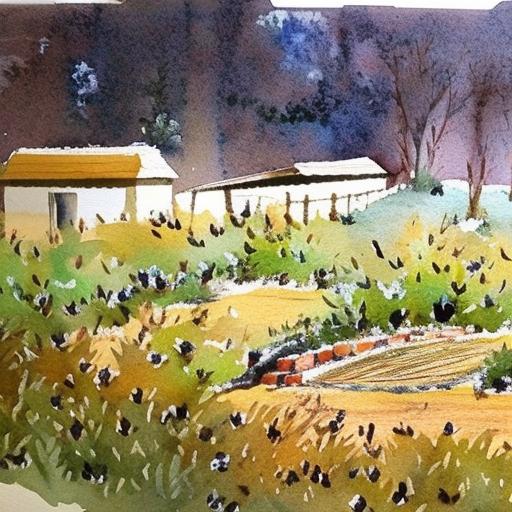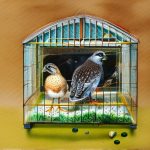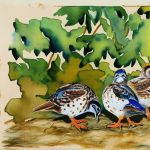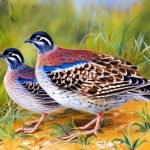When it comes to choosing the right location for your quail breeding pen, there are several factors to consider. First and foremost, you’ll want to select a location that is well-drained and free from standing water. Quail are susceptible to respiratory issues, so it’s important to keep their environment dry and free from excessive moisture. Additionally, you’ll want to choose a location that is protected from strong winds and extreme weather conditions. This will help to ensure that your quail are comfortable and safe in their breeding pen.
Another important consideration when choosing a location for your quail breeding pen is predator protection. Quail are small and vulnerable to predators such as raccoons, foxes, and birds of prey. It’s essential to select a location that can be easily secured with fencing or other predator deterrents. Additionally, you’ll want to choose a location that is easily accessible for daily maintenance and care. This will make it easier for you to monitor your quail and provide them with the attention they need to thrive. Overall, selecting the right location for your quail breeding pen is crucial for the health and safety of your birds.
Key Takeaways
- Choose a location with good drainage, protection from predators, and easy access for maintenance when setting up a quail breeding pen.
- When designing and constructing the pen, prioritize ventilation, insulation, and easy cleaning to ensure a healthy environment for the quail.
- Provide a stress-free environment with proper lighting, temperature control, and nesting areas to encourage successful quail breeding.
- Select breeding stock with good genetics, health, and temperament to ensure strong and productive offspring.
- Offer a balanced diet, clean water, and regular health checks to ensure the well-being of quail in the breeding pen.
Designing and Constructing the Quail Breeding Pen
Once you’ve chosen the right location for your quail breeding pen, it’s time to design and construct the pen itself. When designing your quail breeding pen, it’s important to consider the space requirements for your birds. Quail are social animals and require ample space to move around and exhibit natural behaviors. A good rule of thumb is to provide at least 1 square foot of space per bird in the breeding pen. This will help to prevent overcrowding and reduce stress among your quail.
In terms of construction, there are several key elements to consider when building your quail breeding pen. First, you’ll want to ensure that the pen is secure and predator-proof. This may involve burying wire mesh around the perimeter of the pen to prevent digging predators from gaining access. Additionally, you’ll want to provide adequate shelter for your quail, such as a covered area or small coop where they can roost and seek protection from the elements. It’s also important to consider ventilation in the design of your quail breeding pen. Good air circulation is essential for maintaining a healthy environment for your birds. Finally, you’ll want to consider the materials you use for construction. Durable, weather-resistant materials such as pressure-treated wood or PVC piping can help ensure that your quail breeding pen stands the test of time.
Providing the Right Environment for Quail Breeding
Creating the right environment for quail breeding is essential for the health and productivity of your birds. One of the most important factors to consider is lighting. Quail are sensitive to changes in day length, so it’s important to provide them with a consistent lighting schedule. This can be achieved using artificial lighting in the breeding pen to ensure that your quail receive the appropriate amount of light each day. In addition to lighting, it’s important to provide your quail with a clean and comfortable nesting area. This will encourage them to lay eggs and increase the likelihood of successful breeding.
Another key aspect of providing the right environment for quail breeding is temperature control. Quail are sensitive to temperature extremes, so it’s important to keep their breeding pen within a comfortable temperature range. This may involve providing heating or cooling options depending on the climate in your area. Additionally, it’s important to keep the breeding pen clean and free from excessive dust and debris. Regular cleaning and maintenance will help to prevent respiratory issues and other health problems in your quail. Overall, creating the right environment for quail breeding involves careful attention to lighting, nesting areas, temperature control, and cleanliness.
Selecting the Right Quail Breeding Stock
Selecting the right quail breeding stock is crucial for producing healthy offspring with desirable traits. When choosing breeding stock, it’s important to select birds that are healthy, active, and free from genetic defects. Look for birds that exhibit good body conformation and have a strong, robust appearance. Additionally, it’s important to consider the age of the birds you select for breeding. Younger birds are generally more fertile and productive than older birds, so it’s a good idea to choose breeding stock that is relatively young and in their prime reproductive years.
In addition to physical traits, it’s important to consider the genetic diversity of your breeding stock. Inbreeding can lead to genetic abnormalities and reduced fertility in offspring, so it’s important to select breeding stock from diverse genetic backgrounds. This may involve acquiring birds from different sources or trading stock with other breeders to introduce new genetic material into your breeding program. Finally, it’s important to monitor the performance of your breeding stock over time. Keep detailed records of egg production, hatch rates, and overall health to identify which birds are the most productive and which should be culled from the breeding program. By carefully selecting and monitoring your quail breeding stock, you can improve the overall quality of your flock and ensure long-term breeding success.
Feeding and Caring for Quail in the Breeding Pen
Feeding and caring for quail in the breeding pen is essential for maintaining their health and productivity. When it comes to feeding, it’s important to provide your quail with a balanced diet that meets their nutritional needs. This may involve offering a commercial game bird feed that is specifically formulated for quail, as well as supplementing their diet with fresh greens, fruits, and protein sources such as mealworms or crickets. It’s important to monitor your quail’s body condition and adjust their diet as needed to ensure that they are receiving adequate nutrition.
In addition to feeding, it’s important to provide your quail with clean water at all times. Quail are sensitive to dehydration, so it’s essential to regularly check their water supply and clean their waterers to prevent contamination. It’s also important to monitor the overall health of your quail in the breeding pen. Keep an eye out for signs of illness or injury, such as lethargy, decreased appetite, or abnormal behavior. If you notice any concerning symptoms, it’s important to take action quickly by isolating sick birds and seeking veterinary care if necessary.
Managing Breeding and Hatching in the Quail Breeding Pen
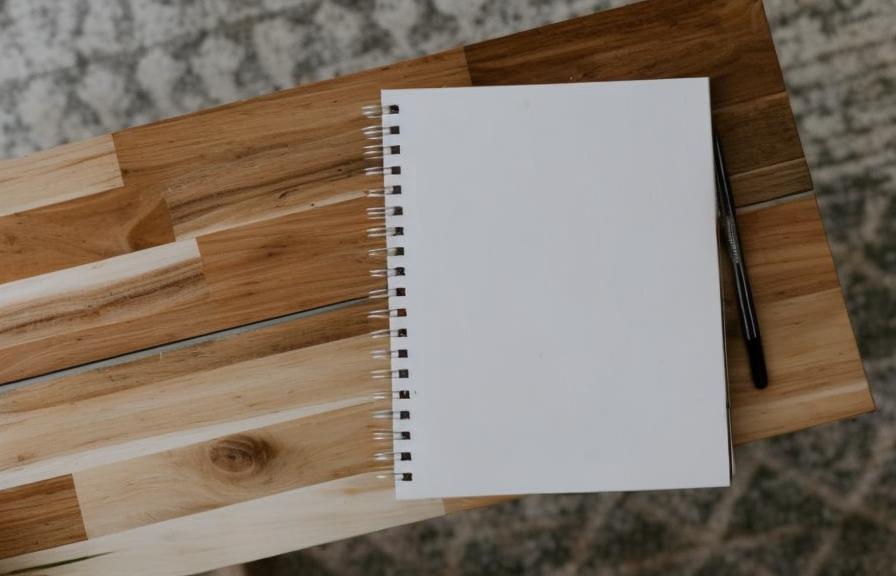
Managing breeding and hatching in the quail breeding pen requires careful attention to detail and timing. When it comes to breeding, it’s important to introduce males and females at the right time to maximize fertility and egg production. This may involve keeping track of each bird’s laying patterns and behavior to identify when they are most receptive to mating. Additionally, it’s important to provide suitable nesting areas for your quail to lay their eggs. This may involve providing nesting boxes or other suitable materials where your quail can lay their eggs in a safe and comfortable environment.
Once eggs have been laid, it’s important to carefully monitor them for signs of fertility and development. This may involve regular candling of the eggs to check for signs of embryo development. It’s also important to maintain proper temperature and humidity levels in the incubation area to ensure successful hatching. Once chicks begin to hatch, it’s important to provide them with a warm, clean environment where they can dry off and begin feeding. Managing breeding and hatching in the quail breeding pen requires careful observation and intervention when necessary to ensure successful reproduction and healthy offspring.
Troubleshooting Common Issues in Quail Breeding Pens
Despite your best efforts, you may encounter common issues in your quail breeding pen that require troubleshooting and intervention. One common issue is egg eating, where quail may develop a habit of consuming their own eggs. This behavior can be caused by stress, overcrowding, or nutritional deficiencies. To address this issue, it’s important to identify and address the underlying cause by providing a stress-free environment, adequate space, and a balanced diet for your quail.
Another common issue in quail breeding pens is aggression among birds, particularly during mating season or when introducing new birds into the flock. Aggression can lead to injuries and decreased productivity among your quail. To address this issue, it’s important to provide ample space and hiding spots within the breeding pen where birds can escape aggressive individuals. Additionally, monitoring bird behavior closely can help identify potential aggressors that may need to be separated from the flock.
In conclusion, successful quail breeding requires careful attention to every aspect of their care and environment. By choosing the right location, designing a suitable pen, providing a conducive environment for breeding, selecting healthy breeding stock, feeding and caring for them properly, managing breeding and hatching effectively, and troubleshooting common issues as they arise, you can ensure a successful and sustainable quail breeding operation.
In conclusion, successful quail breeding requires careful attention to every aspect of their care and environment. By choosing the right location, designing a suitable pen, providing a conducive environment for breeding, selecting healthy breeding stock, feeding and caring for them properly, managing breeding and hatching effectively, and troubleshooting common issues as they arise, you can ensure a successful and sustainable quail breeding operation. Attention to detail and proactive management are key to ensuring the health and productivity of your quail flock. With proper care and attention, you can enjoy the rewards of a thriving quail breeding operation.
If you’re looking to build a quail breeding pen, you may also be interested in learning about innovative chicken coop designs. Check out this article on how to turn a trampoline into a chicken coop on PoultryWizard. It offers creative ideas for repurposing materials and creating a comfortable living space for your poultry. Learn more here.
FAQs
What is a quail breeding pen?
A quail breeding pen is a specially designed enclosure used for breeding and raising quails. It provides a controlled environment for quails to mate, lay eggs, and raise their young.
What are the benefits of using a quail breeding pen?
Using a quail breeding pen allows for better control over the breeding process, resulting in higher success rates for hatching and raising healthy quail chicks. It also helps to protect the quails from predators and provides a more organized and efficient way of managing a quail breeding operation.
What are the key features of a quail breeding pen?
A quail breeding pen typically includes features such as separate nesting areas for the quails, a secure enclosure to protect them from predators, easy access for egg collection, and adequate space for the quails to move around and exercise.
How do you build a quail breeding pen?
To build a quail breeding pen, you will need to consider factors such as the size of the pen, the materials to be used, the layout of the nesting areas, and the security measures to protect the quails. Detailed instructions can be found in the article “How to Build a Quail Breeding Pen”.
What are some important considerations when building a quail breeding pen?
When building a quail breeding pen, it is important to consider factors such as ventilation, lighting, temperature control, and sanitation. These factors are crucial for the health and well-being of the quails and can impact the success of the breeding operation.
Meet Walter, the feathered-friend fanatic of Florida! Nestled in the sunshine state, Walter struts through life with his feathered companions, clucking his way to happiness. With a coop that’s fancier than a five-star hotel, he’s the Don Juan of the chicken world. When he’s not teaching his hens to do the cha-cha, you’ll find him in a heated debate with his prized rooster, Sir Clucks-a-Lot. Walter’s poultry passion is no yolk; he’s the sunny-side-up guy you never knew you needed in your flock of friends!

